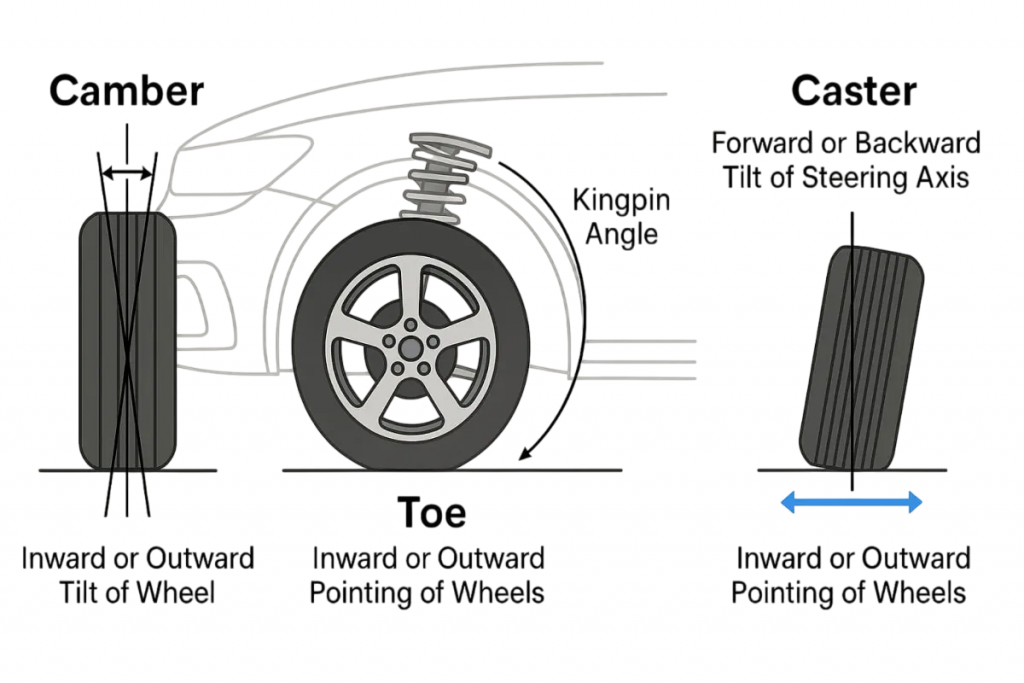
- Understanding Steering Geometry
- What Exactly Is Steering Geometry?
- The Core Components of Steering Geometry
- Why Proper Steering Geometry is Crucial
- How Steering Geometry Impacts Vehicle Handling and Safety
- Steering Geometry in Electric Vehicles (EVs)
- Recognizing the Signs of Poor Wheel Alignment
- Getting Your Steering Geometry Checked and Corrected
- Conclusion
Understanding Steering Geometry
Have you ever thought about what keeps your car going straight without you having to adjust it all the time? Or how it can turn easily into a corner, with all four tires working together? It’s not magic, it’s a detailed science called steering geometry. This system of angles and measurements determines how your wheels connect with the road. To explore how intelligent systems refine steering geometry through predictive modeling, sensor integration, and adaptive control, explore Artificial Intelligence Training a hands-on course that covers machine learning, embedded AI, and advanced automotive engineering applications for precision driving dynamics. Getting it right is important for safety, tire lifespan, and overall vehicle control. Whether you drive a regular gasoline car or a modern electric vehicle, knowing the basics of steering geometry can make you a more informed owner and a safer driver.
What Exactly Is Steering Geometry?
At its core, steering geometry refers to the angles between your car’s front wheels, the suspension system, and the ground. Think of it as the blueprint for how your vehicle steers, corners, and stays stable. In hybrid and electric models, precise steering geometry ensures smooth handling and efficient energy use, especially when balancing the dual power sources of engine and motor. To explore how these systems integrate with advanced hybrid technology, explore Plug-In Hybrid Electric Vehicle a comprehensive guide that explains PHEV architecture, energy flow, charging options, and the engineering strategies that make plug-in hybrids a practical bridge toward full electrification. Engineers carefully calculate these angles to provide the best balance of responsive steering, driver comfort, and predictable handling. When everything is set correctly in a process called wheel alignment, your car feels stable, your steering is centered, and your tires wear evenly. However, if these angles are even slightly off, it can cause many problems.
Ready to Get Certified in Artificial Intelligence ? Explore the Program Now Artificial Intelligence Online Training Offered By ACTE Right Now!
The Core Components of Steering Geometry
Steering geometry is defined by several key angles. While the names might sound technical, their functions are quite straightforward, ensuring stability, smooth cornering, and precise control. In the context of modern mobility, these mechanical fundamentals are just as important as the innovations driving electrification. To explore how traditional vehicle dynamics align with sustainable mobility solutions, explore Electric Vehicles a comprehensive guide that explains EV classifications, working principles, component integration, and the advancements shaping the future of transportation.
- Camber: This is the vertical tilt of your wheels when viewed from the front of the vehicle. If the top of the wheel tilts outward, it’s called positive camber. If it tilts inward, it’s negative camber. The correct camber angle helps maximize the tire’s contact patch with the road during cornering, improving grip.
- Caster: This angle refers to the forward or backward slope of the steering axis when viewed from the side. A good way to visualize it is by looking at the wheels on a shopping cart, which have a significant caster angle that helps them self-center and follow the direction you push. In a car, positive caster improves straight-line stability and helps the steering wheel return to the center after a turn.
- Toe: This is the direction your wheels are pointing when viewed from above. If the front of the wheels points slightly inward, it’s called toe-in. If they point outward, it’s toe-out. Toe settings are critical for ensuring straight-line stability, proper steering response, and minimizing tire wear.
- Ackermann Principle: This is a fundamental concept in steering geometry that ensures the inside wheel turns at a sharper angle than the outside wheel during a turn. This difference is necessary because the inside wheel travels on a smaller circle. The Ackermann principle prevents the tires from scrubbing or dragging sideways, leading to smoother turns and less tire wear.
- Enhanced Safety: Proper wheel alignment ensures your vehicle is stable and predictable, especially during emergency maneuvers or in poor weather conditions.
- Improved Vehicle Handling: A car with correct geometry feels more responsive and connected to the road. Steering is precise, and cornering is smooth, giving the driver more confidence.
- Increased Tire Lifespan: Misaligned wheels are a leading cause of premature and uneven tire wear. Correct geometry ensures the tires meet the road flatly, distributing wear evenly and saving you money.
- Better Fuel and Energy Efficiency: When wheels are misaligned, they create extra rolling resistance, forcing the engine or electric motor to work harder. Proper alignment reduces this drag, which can improve fuel economy or extend the range of an electric vehicle.
- When to Get an Alignment: It’s a good idea to have your alignment checked annually, whenever you install new tires, or after a significant impact with a pothole or curb. You should also get it checked if you notice any of the warning signs mentioned above.
- What is a Wheel Alignment: A wheel alignment is the process of adjusting the key angles of the camber, caster, and toe back to the vehicle manufacturer’s precise specifications.
- Trust a Professional: This is not a DIY job. Technicians use highly sensitive laser-guided machines to measure the angles and make precise adjustments to the suspension system components.
- Two-Wheel vs. Four-Wheel: Most modern vehicles, especially all-wheel-drive models and EVs, require a four-wheel alignment to ensure both front and rear axles are working together perfectly.

To Explore Artificial Intelligence in Depth, Check Out Our Comprehensive Artificial Intelligence Online Training To Gain Insights From Our Experts!
Why Proper Steering Geometry is Crucial
Maintaining the correct steering geometry isn’t just about technical perfection; it delivers real-world benefits that every driver can appreciate, such as improved handling, reduced tire wear, and enhanced safety. In the same way, adopting electric vehicles comes with both strengths and challenges that shape the driving experience and ownership journey. To explore these aspects in detail, explore Advantages and Disadvantages of EV a comprehensive guide that explains performance benefits, cost savings, environmental impact, as well as limitations like charging infrastructure, range, and upfront investment.
How Steering Geometry Impacts Vehicle Handling and Safety
The link between steering geometry and vehicle handling is direct and important. When the angles meet the manufacturer’s specifications, your car drives as it should. It will stay straight on the highway with little effort and feel stable during turns, thanks to precise control systems that manage power delivery and vehicle dynamics. These systems rely heavily on semiconductor devices that regulate voltage, current, and switching efficiency. To explore how these components differ and their impact on EV performance, explore IGBT and MOSFET a comprehensive guide that explains their characteristics, efficiency trade-offs, switching behavior, and the role they play in modern electric vehicle power electronics. This stability is key for vehicle safety. On the other hand, poor geometry can make a car feel unstable or unpredictable. It may drift in its lane, pull to one side, or respond slowly to steering. In an emergency, this lack of control can be risky, making it harder to dodge an obstacle or regain control after a skid.
Steering Geometry in Electric Vehicles (EVs)
While the principles of steering geometry are universal, they are especially important in electric vehicles. The unique features of EVs, such as their heavy battery packs, instant torque delivery, and regenerative braking systems, create different demands on the tires and suspension system. To explore how intelligent systems address these challenges through predictive maintenance, smart suspension tuning, and adaptive performance optimization, explore Artificial Intelligence Training a hands-on course that covers machine learning, embedded AI, and advanced automotive engineering applications for next-generation electric vehicles. The added weight makes precise camber and toe settings even more essential for managing tire wear. Additionally, optimizing for low rolling resistance is vital for maximizing an EV’s range. Therefore, proper electric vehicle steering alignment is not just about handling; it is a key factor in the vehicle’s overall efficiency and performance.
Looking to Master Machine Learning? Discover the Artificial Intelligence Expert Masters Program Training Course Available at ACTE Now!
Recognizing the Signs of Poor Wheel Alignment
Your car often sends clear signals when its steering isn’t right. Ignoring these signs can lead to more costly repairs later, so it’s important to take notice. In the world of advanced EVs, Tesla models are designed with intelligent diagnostics and precision engineering that help drivers detect and correct such issues early. To explore how these innovations work and the unique technologies behind Tesla’s success, explore Tesla Electric Vehicles a comprehensive guide that explains Tesla’s architecture, battery systems, autopilot features, and the engineering breakthroughs that set them apart in the EV industry. You might feel your vehicle pulling to one side as you try to drive straight, or your steering wheel may look crooked even when your wheels face forward. Another common sign is uneven or quick tire wear, especially on the inner or outer edges of the tires. You might also hear your tires squeal when you make normal turns. If you notice any of these issues, it strongly suggests you need a wheel alignment.
Preparing for Artificial Intelligence Job Interviews? Have a Look at Our Blog on Artificial Intelligence Interview Questions and Answers To Ace Your Interview!
Getting Your Steering Geometry Checked and Corrected
Keeping your car’s steering geometry in check is a straightforward maintenance task that should be done by a professional. Just as proper alignment ensures stability and safety, regenerative braking systems in EVs enhance efficiency by converting kinetic energy back into stored electrical power. To explore how this innovative technology works and its impact on driving performance, explore Electric Vehicles with Regenerative Braking a comprehensive guide that explains braking energy recovery, system integration, efficiency gains, and the role regenerative braking plays in extending battery life.

Conclusion
Steering geometry is often overlooked, but it is a crucial part of your vehicle’s health. It plays a key role in your car’s stability, affects its handling, and helps protect your tires from wearing out too quickly. To explore how intelligent systems enhance vehicle stability through predictive diagnostics, smart suspension control, and adaptive performance optimization, explore Artificial Intelligence Training a hands-on course that covers machine learning, embedded AI, and advanced automotive engineering applications for safer and more efficient driving. Proper wheel alignment involves understanding angles like caster and camber, as well as the basic action of driving straight. By knowing its importance and spotting the signs of a problem, you can keep your vehicle whether it runs on gas or electricity safe, efficient, and fun to drive for many years.




